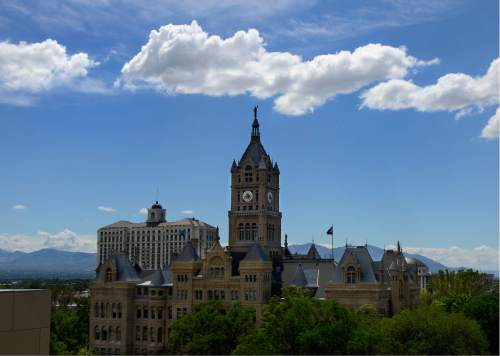This is an archived article that was published on sltrib.com in 2016, and information in the article may be outdated. It is provided only for personal research purposes and may not be reprinted.
Salt Lake City's belt tightening is evident in the austere $259 million general fund budget — up about 1 percent — approved Tuesday by the City Council.
Mayor Jackie Biskupski's proposed budget for the fiscal year beginning July 1 was so lean it gave the council little wiggle room to make significant headway on lingering issues, such as golf, the city's aging vehicle fleet and maintenance of facilities.
The budget includes no new taxes.
City employees will receive a pay increase of 1.25 percent.
The mayor did, however, find an extra $7.5 million for streets to add to the $9.8 million budget. During the fiscal year that ends June 30, the streets budget was $9.6 million.
According to the city's engineering department, two-thirds of the capital's 1,855 miles of roadways are rated "poor" or "very poor." The municipality's seven-year street-maintenance program calls for $22.7 million annually — a target that hasn't been hit in a decade.
Biskupski's budget does include a major change from previous years, in that the mayor moved maintenance of parks and facilities out of the Capital Improvements Program (CIP) and into the general fund. That required slashing the parks budget by 57 percent from 2015-16 funding, while maintenance for facilities took a 41 percent cut.
Historically, the CIP has been a source of maintenance funding, but its allocation is variable and often goes to special projects. While the cuts are deep, the mayor said her budget guarantees that parks and facilities get some funding. Debt service on CIP projects has increased dramatically and will remain high for the next four years, according to the mayor's budget.
The city needs more revenue. Funding from property taxes for the 2016-17 budget are projected to be up about $1 million. Sales taxes are expected to increase by about $2.8 million. The small growth, accompanied with the capital's legal obligation to provide a balanced budget, means there are few options to address big-ticket problems.
The "prison sales tax" was not on the table. The 0.5 percent sales-tax option was tucked into legislation that set a deadline for a commission selecting a new site for the Utah State Prison. Lawmakers later approved, as many predicted, moving the prison from Draper to Salt Lake City.
But Biskupski said she is not ready to levy the tax and noted that it cannot be imposed until the prison is under construction.
In a last-minute budget adjustment, the mayor proposed and the council approved a total of $580,000 to mitigate issues on homelessness in the Rio Grande area around The Road Home shelter. It includes $100,000 to increase police foot patrols, $150,000 for a pilot project to provide access to behavioral-health assessments, $50,000 to help disburse campers from 500 West, $45,000 for additional storage space for homeless people and additional funding for the team of homeless people who clean the area.
The council also appropriated an additional $200,000 for toilets on trailers in the Rio Grande area.
The independent golf fund receives no money from the general fund. Nonetheless, the council did discuss options, such as bonding to catch up on $20 million in deferred golf course maintenance. But it took no action. The $8 million fund that operates the six-course system is running an operational deficit of $1.5 million. It could, however, yield a modest $16,000 surplus this season, according to golf officials.
Hanging over the budget and the city's overall fiscal health is the issue of construction impact fees and City Hall's inability to spend them.
In October, the City Council, in a split 4-2 vote, adopted then-Mayor Ralph Becker's proposal to place a moratorium on fees assessed on new development. The moratorium ends Nov. 1.
The city has collected more than $21 million in impact fees, with $8.3 million of that allocated to projects underway or set to begin. If the fees are not spent within six years, they must be returned to developers, according to state law. Salt Lake City has begun the payback process with a few developers, according to council members.
Impact fees are designed to maintain municipal service levels as populations grow. But the money cannot be used for maintenance, like repaving roads, upkeep on parks or buffing up existing facilities — areas where the municipality is strapped.
Nonetheless, impact fees could be used on new projects, and that, theoretically, would free up funding for maintenance. The mayor's proposed budget does recommend spending $2.5 million in impact fees, some earmarked for the construction of a new firehouse — Station 14.
A consultant's report on how to make better use of those funds is expected in the coming weeks.



